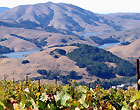Coming in from the cold
Once thought too chilly for most wine grapes, Marin County is emerging as a region with great potential.
By Patrick Comiskey, Special to The Times
February 14, 2007, Los Angeles Times
 |
 |
Nicasio — UNLESS you've been living under an air-conditioned rock for the last couple of decades, you may have noticed signs that the world seems to be getting warmer. It's been widely reported that the trend is likely to wreak some interesting havoc upon California's wine regions in the not-too-distant future, leaving Napa and parts of Sonoma with conditions that resemble the Central Valley. And wine-growing regions once thought to be extreme, like Marin County, the sprawling coastal county north of San Francisco whose cliffs form the northern edge of the Golden Gate, are finding their way to the center.
Marin has long been considered too cool, too foggy and too marginal for anything but sparkling wine grapes. But all that's changing. In the last decade, a small but ardent group of viticulturalists has been farming vineyards there and attracting winemaking talent. Not long ago, the Chalone Group (now owned by wine-industry giant Diageo) planted a spectacular vineyard in the Nicasio Valley for its new Pinot Noir project, Orogeny. And filmmaker George Lucas recently planted 20 acres of Pinot Noir and Chardonnay at Skywalker Ranch to augment his tiny vanity label, Viandante del Cielo.
Whether or not global warming is a factor, the county's reputation for grapes has gone from marginal to viable in a very short period of time.
Of course, Marin County is more famous for its counterculture than its viticulture, but wine grapes have been here for nearly two centuries, beginning with plantings by Spanish settlers at Mission San Rafael in 1817. As the century progressed, immigrants planted so many vines that a souvenir booklet from 1893 boasts "every dweller from Fairfax to Sausalito has his little vineyard." Earthquakes, Prohibition and phylloxera brought an end to this cottage industry, but interest was rekindled in the early 1980s as Napa and Sonoma became wine tourism destinations.
Marin vineyards tend to be set fairly close to the Pacific, and they're subject to dramatic daily fluctuations of temperature, along with moisture and fog. Most of them at one time or another have been farmed by grower Mark Pasternak.
Pasternak, 54, manages much of the vineyard land in Marin, including his own property, Devil's Gulch Ranch, overlooking the town of Nicasio. An L.A. native who decided at an early age to become a farmer, Pasternak has done little else since moving north in the early 1970s. He's farmed fruit trees and leafy vegetables, grown comfrey and alfalfa for pig fodder, even raised prized rabbits that are roasted and rilletted in many Bay Area restaurants, as well as at L.A.'s Spago and Sona. (In true Marin tradition, years ago, Pasternak had been known to grow an agent of intoxication other than wine grapes as well. His riskiest venture these days, however, aside from grapes, is a summer agricultural day camp for kids.)
For the first decade, Pasternak sold all of his fruit to sparkling wine producers — a safe bet, since sparkling wine doesn't require fully ripe fruit. Even at its warmest, Marin's climate is distressingly cool: When the temperature is hitting the mid-90s in the Napa Valley, most Marin growers are lucky if it reaches 80 in their vineyards.
But Pasternak's efforts were aided by one consistent pattern. In a typical season, vines bud in the middle of February, and fruit hangs into late September. "The season here is horrendously long," Pasternak says, "much longer than virtually the rest of the state."
How it all began
IN 1990, Pasternak found himself with a huge fruit surplus. So he contacted winemakers he admired and made them an offer: They could take a ton of grapes off his hands for nothing. If they made wine, and liked the results, they could cut him a check. "The only guy who took me up on it was Dan Goldfield," Pasternak says.
Winemaker Dan Goldfield came to the Russian River Valley in Sonoma County early in his career and pretty much hasn't left since; after formative stints at La Crema and Hartford Court, Goldfield teamed up with Steve Dutton, whose family's vineyards in the Russian River, Green Valley and Sonoma Coast American Viticultural Areas have been standard bearers for cool-weather fruit in Sonoma.
In less than a decade, Dutton Goldfield has became a winery defined by these outer reaches of California viticulture. When Pasternak offered the winery a ton of grapes, and thereby the chance to extend its range into Marin, Goldfield jumped at the opportunity.
"A lot of people said you can't grow grapes here," Goldfield says. "But I like being out on the edge."
On a beautiful cloudless day last October, I toured the Devil's Gulch vineyard with Pasternak and Goldfield. This steeply terraced vineyard overlooking the Nicasio Reservoir is planted largely to Pinot Noir and Chardonnay on soils of fractured, mineral-flecked sandstone. Nets were flung over the vines to protect the fruit from the birds above our heads. Even without bird pressure, yields are puny. A good vintage yields 2 tons an acre. In the Russian River region, twice that figure is common.
Goldfield buys half of Pasternak's Pinot from Devil's Gulch to make a vineyard designate. The other half goes to Bolinas resident Sean Thackrey, whose Rhône-inspired blends like Pleiades, Orion and Sirius have been underground favorites for wine collectors for years. Andromeda is Thackrey's first commercial Pinot Noir. He's made Pinots before, he's just never released them: Andromeda is the first to have the complexity he's looking for.
"You get such great intensity here," Thackrey says. "That concentration is one of its hallmarks."
The Pinots from Devil's Gulch are surprisingly dark, with plum and blueberry fruit accented by a clean, almost minty herbal top note. That intensity seems anomalous. Most cool-weather sites yield lighter, less concentrated wines — think New Zealand, or Burgundy in a cool year. The paradox is explained by the presence of the wind; an incessant stream of it travels into the Nicasio Valley by way of Tomales Bay, harassing grapes into transpiration (losing moisture) and thickening their skins. "I'm an agnostic about terroir," Thackrey says, "but this place is a situation unto its own, with all of the wind he gets here."
Thackrey is equally agnostic about global warming. "The real story is a greater willingness to deal with cooler regions," Thackrey says. "Remember that Carneros was once considered absolutely marginal. Fifty years ago, nobody would have dreamed to plant grapes there."
Jonathan and Susan Pey are perhaps the most articulate proponents of Marin's viticultural potential. They founded two Marin-based winery brands, Mt. Tamalpais in 1999 and Pey-Marin in 2001, and bring many years of experience to their efforts. Jonathan served as the general manager for several large wineries, including Robert Mondavi, Rosemount and Penfolds N.A. Susan, meanwhile, directs the wine program for the Il Fornaio restaurant chain.
"Marin's capable of producing wines of great varietal purity," Jonathan says. "Flavors come before sugars here, not the other way around."
The key to growing on the edge, according to Jonathan, is to alter your growing practices to the demands of the climate. To establish a viable fruit zone, "we really had to correct the vine's architecture," he explains, by trimming the plant, opening the canopy and exposing clusters to sunlight. "We have no problem getting things ripe here if you can get the sun on the fruit." The Peys make a Pinot Noir called Trois Filles which is richer and slightly more earthy than the wines from Devil's Gulch, as well as a succulent, gripping Merlot and a brisk citrusy Riesling — the only one in the county.
Marin wine country's outer edge may well be the Stubbs Vineyard in Marshall, just a few miles inland from Tomales Bay and the most westerly vineyard in the county. Tom and Mary Stubbs planted 11 acres of Pinot Noir and Chardonnay on their idyllic 600-acre ranch in West Marin 10 years ago.
The proximity of the Stubbs Ranch to the ocean has led to an unorthodox planting, in the swale of a valley, set far from the ridgeline and largely off the hill.
"Normally you decide to plant on hillsides," Tom Stubbs explains, "but out here, the valleys are so much safer, out of the wind."
Stubbs used to sell his grapes to Schramsberg, the Calistoga sparkling wine entity, but he was never comfortable with the arrangement. "You can never really gain an identity, contributing to a sparkling wine," he points out. "Not us, and not the county." So he sought out Goldfield, and started making wines.
The Stubbs Vineyard Pinot and Chardonnay don't have the intensity of Devil's Gulch, but in Burgundian varieties, that's hardly a shortcoming. Both have an aromatic finesse and a lacy delicacy on the palate that speaks to their cool weather roots, a grace and a lightness that suggests this nascent wine region may have a plurality of voices as it defines its identity.
*
Look for these Marin County Pinots
OVER the years, Marin County fruit has contributed to a number of California sparkling wines. Schramsberg has purchased fruit from Marin sources including Stubbs and Devil's Gulch Ranch. Another longtime advocate of Marin fruit for sparkling wine is the wonderfully idiosyncratic Kalin Cellars, owned by Terry Leighton, whose long-aged sparkling wines (the current release is from 1988) can be exotic and marvelous.
Here are tasting notes on a selection of Marin Pinot Noirs. These wines are made in such small quantities that they are difficult to find at retailers; check winery websites for details and direct orders.
2005 Vision Cellars Chileno Valley Marin Country Pinot Noir. A lively, youthful wine with impressive concentration and an extra oomph of texture from adding clusters to the fermentation. Scents of dark cherry give way to a deeply flavored, earthy wine with a long spicy finish. At visioncellars.com, $32.
2004 Stubbs Vineyard Estate Pinot Noir. The lightest, most "clear-eyed" of the wines here. Lighter in color, it has aromatics of wild strawberries and a mildly rosy floral scent. It's clean and light on the palate with vinous flavors of cranberry and herb. At stubbsvineyard.com, $36.
2004 Pey-Marin Pinot Noir. An earthy and slightly thick wine — but those earthy flavors are toothsome. It's chewy without being rich, with a nice foresty scent and green flavors. Pillow of black cherry fruit and redwood, barky finish. At marinwines.com, $36.
2003 Thackrey Devil's Gulch Ranch Andromeda Pinot Noir. Perhaps the darkest of the Pinots here, with dark, almost blueberry aromas and that classic Thackrey touch of eucalyptus. It has a Burgundian spiciness in its flavors. A concentrated wine, with black cherry fruit, balanced and cleanly delivered. At wine-maker.net, $60.
2004 Dutton Goldfield Devil's Gulch Ranch Pinot Noir. Structured like an old Carneros Pinot, with a smoky edge and rippling acidity, this is nevertheless a dark-fruited wine, with deep, earthy black cherry and plum. Its lean texture runs counter to so many California Pinots — it isn't puffed up — and contributes to a real Pinot feel in the mouth. At duttongoldfield.com, $52.
— Patrick Comiskey



